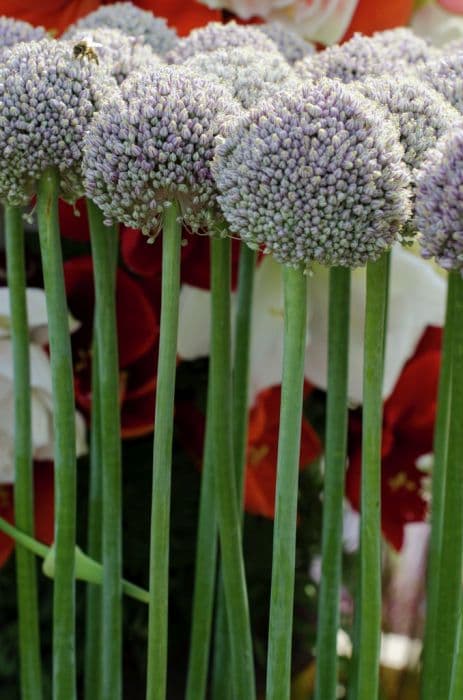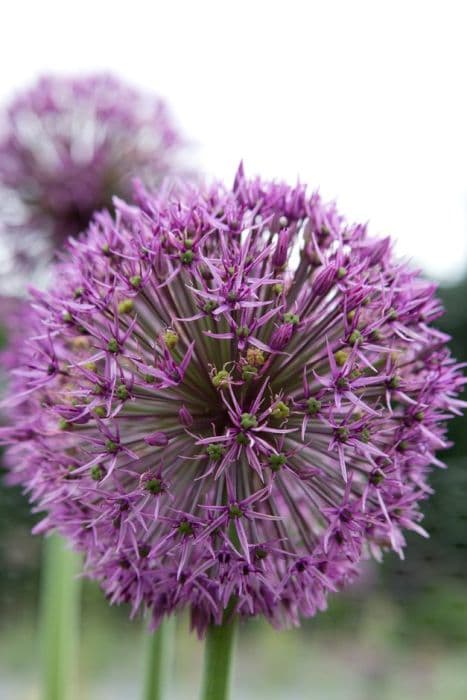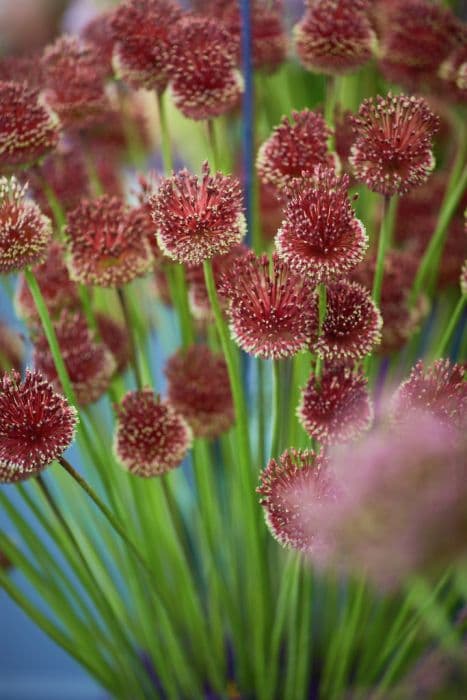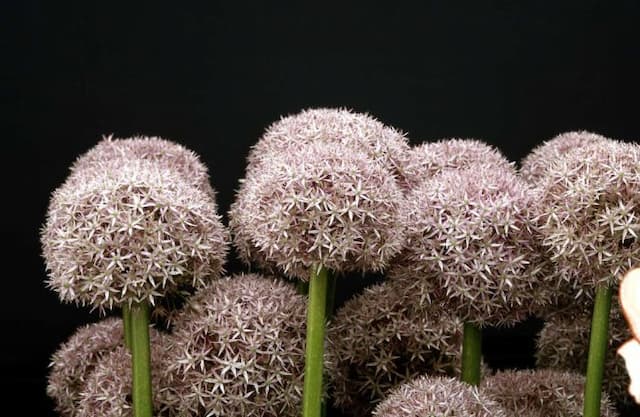Spring Starflower Ipheion uniflorum 'Charlotte Bishop'

ABOUT
Charlotte Bishop is a delightful flowering plant known for its star-shaped blossoms, which hold a captivating pale pink hue with a darker pink stripe running down the center of each petal. The petals gracefully arch back, creating an almost spinning effect around the prominent stamens that explode in a contrasting shade. The leaves of Charlotte Bishop are slender, grass-like, and appear as an elegant lush green that provides a complementary backdrop to the standout flowers. The foliage is somewhat glossy, adding an additional textural component to the plant's overall presentation. The flowers are borne on top of sturdy, slender stems that rise just above the foliage, giving it a delicate, airy appearance. Blooms are not singular; they cluster, making a more substantial show of color when in full display. The appearance of this plant is that of a typical spring bloomer, emitting a subtle fragrance that entices passersby and beneficial insects alike. As the season progresses, the blooms of Charlotte Bishop may fade, but they often leave behind intriguing seed heads that add prolonged interest to the garden. In summary, the visual appeal of Charlotte Bishop is composed of its striking flowers, soothing color palette, and elegant form, making it a cherished addition to many garden settings.
About this plant
 Names
NamesFamily
Amaryllidaceae
Synonyms
Spring Starflower, Spring Star, Springstar
Common names
Tristagma uniflorum, Brodiaea uniflora, Milla uniflora, Nothoscordum uniflorum, Triteleia uniflora.
 Toxicity
ToxicityTo humans
Spring starflower is not widely recognized as poisonous to humans. However, it’s always prudent to exercise caution and avoid ingesting any part of ornamental plants due to the potential for unidentified toxins or individual allergic reactions.
To pets
Spring starflower is not commonly listed as a toxic plant to pets, including cats and dogs. Nonetheless, ingestion should still be avoided to prevent any possible gastrointestinal distress or allergic reactions that can vary between individual animals.
 Characteristics
CharacteristicsLife cycle
Perennials
Foliage type
Deciduous
Color of leaves
Green
Flower color
Pink
Height
4-6 inches (10-15 cm)
Spread
3-4 inches (7.5-10 cm)
Plant type
Bulb
Hardiness zones
5
Native area
South America
Benefits
 General Benefits
General Benefits- Low Maintenance: Requires minimal care once established, making it an excellent choice for both novice and experienced gardeners.
- Ease of growth: Grows well in a variety of soils and climatic conditions, which means it can be planted in diverse gardens without much hassle.
- Drought Tolerant: Once established, it can survive with little water, ideal for water-wise landscaping or regions with water restrictions.
- Naturalizing: Has the ability to spread and naturalize over time, creating larger displays of color with no extra effort from the gardener.
- Spring Flowering: Produces lovely blue-violet flowers in early spring, providing an early nectar source for pollinators when few other plants are in bloom.
- Deer and Rodent Resistance: Generally resistant to deer and rodents, so it is less likely to be damaged by wildlife.
- Aesthetic Appeal: The flowers add a beautiful splash of color to gardens, borders, rockeries, and under trees and shrubs with its star-shaped blooms.
- Good for Containers: Suitable for pot cultivation, allowing those with limited space or no garden to enjoy its beauty.
- Low Growing: Its short stature makes it a good choice for front-of-border positions or groundcover, without obscuring other plants.
 Medical Properties
Medical Properties- This plant is not used for medical purposes.
 Air-purifying Qualities
Air-purifying QualitiesThis plant is not specifically known for air purifying qualities.
 Other Uses
Other Uses- The Spring Starflower's bulbs can be crushed and used as a glue due to their sticky sap, which is especially useful in traditional bookbinding and paper repairs.
- The leaves of the Spring Starflower can be woven into small decorative baskets and wreaths, adding a unique touch to handcrafted items.
- The flowers of the Spring Starflower can serve as a natural dye, producing delicate hues for textiles and artisanal crafts.
- The crushed bulbs can also be used in perfumery as a fixative to extend the longevity of scents due to their sticky nature.
- The plant's characteristic scent may be incorporated into potpourri mixes to freshen indoor areas with a subtle and pleasing aroma.
- Spring Starflower can be planted in outdoor pet areas as a non-toxic ground cover, providing a safe environment for pets to play.
- The flowers can be used as bookmarks; their slim profile and sturdy structure allow them to be placed inside books without damaging the pages.
- The sturdy stems can be used to create miniature plant stakes to support other small plants in a garden or as markers for identifying herbs.
- Flowering clumps can be utilized for informal educational activities, like plant lifecycle studies due to their easy growth and visible changes throughout the season.
- The sap from the bulbs can be used as a natural adhesive for creating children’s art projects, providing a safe alternative to commercial glues.
Interesting Facts
 Feng Shui
Feng ShuiThe Spring Starflower is not used in Feng Shui practice.
 Zodiac Sign Compitability
Zodiac Sign CompitabilityThe Spring Starflower is not used in astrology practice.
 Plant Symbolism
Plant Symbolism- Persistency: Ipheion uniflorum, commonly known as Spring Starflower, often blooms early in the season and can push through the last remnants of winter, symbolizing persistence and the ability to overcome challenges.
- Hope: The Spring Starflower signifies the arrival of spring, thus symbolizing hope and the promise of new beginnings.
- Innocence: With its delicate and simple appearance, the Spring Starflower is often associated with purity and innocence.
- Adaptability: Thriving in various climates and adjusting to different soil conditions, the Spring Starflower represents adaptability and resilience.
 Water
WaterThe Spring Starflower should be watered deeply, allowing the soil to become moderately dry between waterings. Typically, this equates to about once weekly watering, depending on the climate and soil drainage. Outdoor plants will benefit from approximately one to one and a half gallons of water per week during active growth periods. During dormancy in winter, reduce watering significantly, only ensuring the soil does not completely dry out. Overwatering can lead to bulb rot, so ensuring good drainage is key.
 Light
LightSpring Starflower thrives in full sun to partial shade. The best spot for this plant is where it can receive at least 4 to 6 hours of sunlight daily. Areas with morning sun and afternoon shade are ideal to protect the plant from the intense heat of late afternoons, especially in hotter climates.
 Temperature
TemperatureSpring Starflower prefers temperate conditions and can generally survive minimum temperatures down to 20 degrees Fahrenheit and maximum temperatures up to 75 degrees Fahrenheit. However, the ideal temperature range for the plant is between 50 and 70 degrees Fahrenheit. Be sure to protect the plant from extreme cold by mulching over the winter, especially in zones where temperatures drop below the survival range.
 Pruning
PruningSpring Starflower typically requires minimal pruning. Deadheading spent blooms can encourage more flowers. After flowering, allow the foliage to die back naturally before trimming, which usually occurs late spring or early summer. It's generally not necessary to prune the plant again until the next flowering cycle.
 Cleaning
CleaningNot needed
 Soil
SoilSpring Starflower prefers well-draining soil with a mixture of loam, sand, and compost to promote good drainage and nutrient content. A slightly acidic to neutral pH ranging from 6.0 to 7.0 is ideal for this plant.
 Repotting
RepottingSpring Starflowers typically do not need frequent repotting; it's best to repot every 2-3 years or when the clumps become overcrowded. The best time for repotting is in the fall after the foliage has died back.
 Humidity & Misting
Humidity & MistingSpring Starflower tolerates a wide range of humidity levels and does not require any special humidity considerations. Average room humidity is suitable for this plant.
 Suitable locations
Suitable locationsIndoor
Place Spring Starflower in bright, indirect light indoors.
Outdoor
Plant Spring Starflower in full sun to partial shade outside.
Hardiness zone
5-9 USDA
 Life cycle
Life cycleIpheion uniflorum 'Charlotte Bishop', commonly known as Spring Starflower, begins its cycle as a bulb, which undergoes a dormant phase during the summer when temperatures are at their peak. In early autumn, the bulb awakens and roots start to develop. As temperatures cool and moisture increases, foliage emerges, consisting of grass-like leaves that persist through the winter. By late winter to early spring, vibrant star-shaped flowers typically of a light violet shade, borne on short stems, bloom above the foliage, attracting early-season pollinators. After flowering, the plant sets seed, which can be dispersed to propagate new individuals. As temperatures rise towards the summer months, the Spring Starflower enters dormancy once again, completing its annual life cycle.
 Propogation
PropogationPropogation time
Spring to early summer
Ipheion uniflorum 'Charlotte Bishop', commonly known as Spring Starflower, is typically propagated through division. This is usually done after the plant has finished flowering and the foliage has begun to die back, which often occurs in late spring or early summer. The bulbs can be gently lifted out of the soil using a trowel or hand fork, being careful not to damage them. Once they are out of the ground, the offsets, which are small bulbs attached to the parent bulb, can be detached and replanted. The offsets should be planted about 3 inches (approximately 7.5 centimeters) deep and spaced about 4 inches (about 10 centimeters) apart in well-draining soil. This method of propagation ensures genetic consistency and is a straightforward way to increase your stock of Spring Starflowers.









